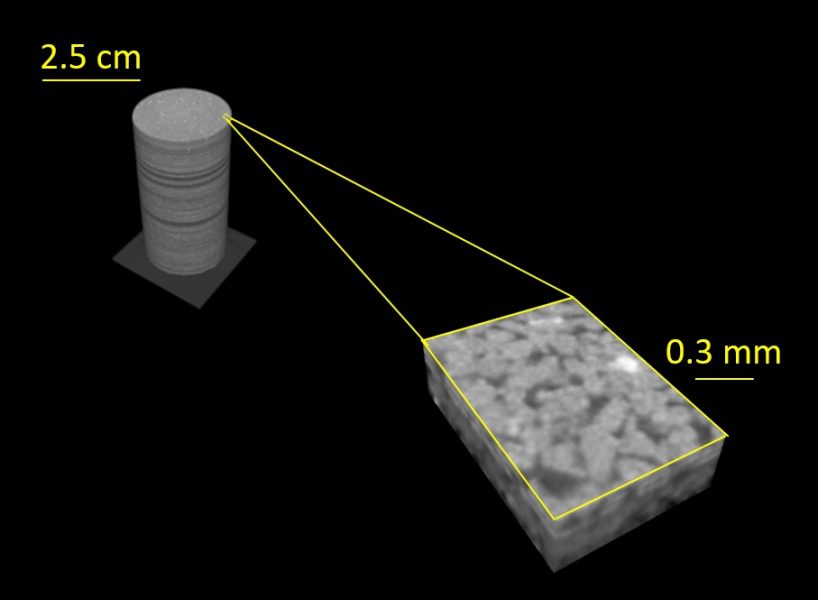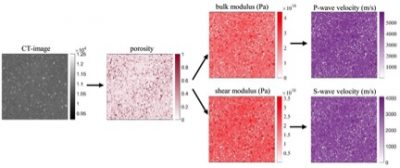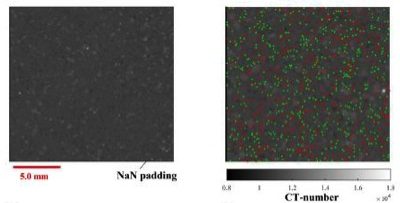Jackson School Team Builds Better Rock Models
June 8, 2020

Once you crush, cut or fracture a rock, there are no do-overs. It’s a fact that means geoscientists have to be particularly careful about which rock samples they can sacrifice to physics experiments versus which ones should stay on the shelf.
A team of geoscience researchers from The University of Texas at Austin is working to change that with a new method for creating digital replicas of rock samples that is more accurate and simpler to use than other techniques.
The digital replicas can take the place of the real thing in certain experiments, allowing scientists to learn about rock samples without having to touch them. They also allow scientists to collect data from samples that are too small to run certain experiments on, such as cuttings brought up when drilling for oil.
“Now we don’t have to take a rock into the lab,” said Ken Ikeda, a graduate student at the UT Jackson School of Geosciences. “We don’t have to risk a sample, there’s no way to ruin it.”
Ikeda is the lead author of a paper published in the Journal of Geophysical Research – Solid Earth that describes the new method. The research was conducted entirely by Jackson School researchers in the Department of Geological Sciences, with the other two authors being graduate student Eric Goldfarb, and Nicola Tisato, an assistant professor in the Jackson School’s Department of Geological Sciences.

In their study, the researchers tested their method against two others, comparing how the three techniques fared at calculating how fast seismic waves could move through a sample. The new method came closest to the speeds measured in the actual sample, with the calculation being off by 4.5%. The other methods were off by 4.7% and 29%.
Seismic velocity data is a fundamental tool used by geoscientists to learn about rock formations underground. But the researchers said that their method could be used for calculating a number of other important rock properties, such as permeability or electrical conductivity.
All digital rock replicas are built using data collected from a CT scan of a rock sample, which provides a high-resolution record of how the rock interacts with X-rays. By analyzing that information, researchers can determine physical properties about the sample.
The other two methods came with processing trade offs. One of these methods can account for pores and fractures in the rock sample – features that have a big influence on overall elasticity – but requires a target, a pure sample of the mineral that makes up the majority of the rock, to be scanned at the same time as the rock. The other method doesn’t require a target, but can’t account for the pores and fractures.

The new technique gets around these trade-offs by sampling itself for targets, using extremes in the X-ray data to find bits of pure mineral—something the researchers call a “pseudotarget”—as well as fractures and pores.
“A rock has certain areas that are pristine, grains of quartz that are pristine, and space, pores, that are totally empty,” Tisato said. “So if you find those points, you have calibration points.”
With no need for a pure mineral target to accompany a sample, the technique simplifies the CT scanning process. The study also shows that, when it comes to calculating seismic speed, the technique is more accurate than the other two methods.
Gary Mavko, a professor emeritus in geophysics at Stanford University who did not take part in the research, said that the study helps advance research in a rapidly growing field.
“This work represents a promising new approach for elastic digital rock physics — the much studied problem of predicting effective elastic properties of porous Earth materials from high-resolution CT image,” he said.
Currently, the new technique can only be applied to samples that are made mostly of a single mineral – such as the Berea Sandstone core used in the study. Nevertheless, there are plenty of fascinating rocks that fit the bill. Goldfarb said he has applied the technique to three Mars meteorites, samples currently being studied by fellow Jackson School graduate student Scott Eckley.
The meteorite example highlights the value of the technique as a way to make rare specimens more accessible for research, Goldfarb said. A high-quality rock replica means you don’t need a meteorite in your lab to be able to study one.
The Jackson School funded the research.
For more information, contact: Anton Caputo, Jackson School of Geosciences, 512-232-9623; Monica Kortsha, Jackson School of Geosciences, 512-471-2241.
